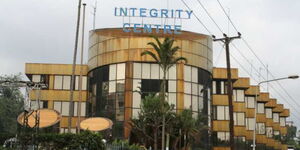Have you ever wondered what use the white marking on a plane engine signified?
I for one always looked at it as a design by the plane just like we have vehicle rims designed to please the eyes or to look cool.
Well, Ruth Karauri, a Boeing 878 Captain at Kenya Airways, put all these questions and doubts into perspective in a Twitter Quiz shared on her handle on Sunday, January 15.
Captain Karauri took to her social media to explain the purpose of the white marking at the centre of the engine of an aeroplane while taking questions from curious netizens.
“What is the purpose of the white marking at the centre of the engine?” She paused.
A user by the name of Ramurn sought to answer, indicating that the marking worked to first alert the ground crew of a running engine; and secondly to mark number one of the turbines. However, Karauri flagged the second function as false.
Another user by the name of Harshly Kups stated, “To indicate to the ground crew that the engine is running as well as to alert birds in flight of the presence of aircraft.”
Francis Ngira opined, “I thought it was some decoration like the artwork Baristas create on our coffee,”
Karauri in acknowledging what the correct reply was revealed that the white markings were for the ground crew to establish if the engine is running or not.
"The engine spiral is a prominent hazard indicator that accentuates the rotating motion of a jet engine’s front air intake fan, so airport ground staff can easily identify a running engine,"
Commonly referred to as the Nosecone spiral, the spiral is an important feature for helping keep the ground crew safe.
These Nosecone spirals are also called spinner spirals, spinner swirls, or nosecone swirls.
According to Aerosavvy, an aviation insight website that provides easy-to-understand answers about airline travel, the nosecone spirals serve two purposes: one is to scare birds and the other is to identify when the engine cone is spinning.
Aerospace engines have swirls painted onto their spinners in order to indicate when the engine is rotating while on the ground.
In flight, these swirls flicker as the engine rotates at high speed, scaring birds and allowing them to fly clear of the engine.
AeroSavvy notes that the spinner spiral’s primary purpose is to warn the ground crew that their engine is still rotating so that the person removing your luggage or performing any maintenance on the aeroplane doesn’t get into the dangerous territory and sucked into the intake.
However, the notion that the spirals scare away birds is debatable because, in flight, the spirals could not be seen by birds as the rotation of the engine would be too fast.
When an engine is running, you see a white blur or a hypnotising twirl, depending on the rotation speed of the engine.
This visual cue is extremely clear and warns everyone on the apron to stay away from the huge jet engines.
When the engine is above idle thrust, the hazard zone increases to 14 feet or more.
Engines on larger jets, like the 777 have much larger hazard zones. It is absolutely critical that ground crews can identify a running engine and stay away from it.












